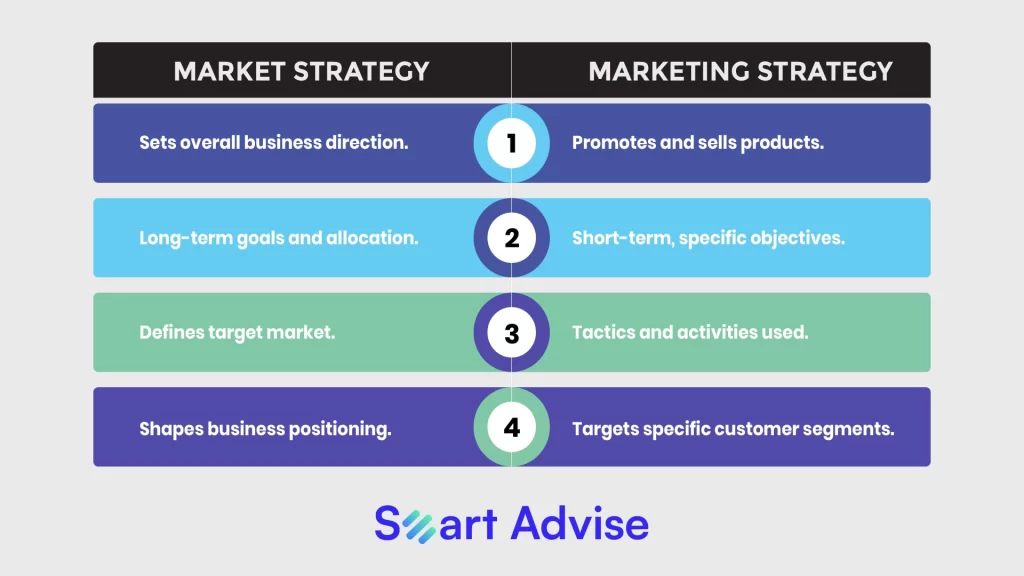
Don’t be misled by these name doppelgangers; understand their distinct yet interconnected nature, which contributes to building a successful business
In business and marketing, there are numerous terms and concepts that often overlap or appear to be closely related. Two such terms that can cause some confusions are “Market Strategy” and “Marketing Strategy.” While they share common elements and objectives, they are distinct in their scope and focus. Understanding the interrelation between these two strategies is crucial for building a successful business. So, let’s begin with…
Defining Market Strategy and Marketing Strategy
Market Strategy
Market strategy is the overarching approach a company takes to thrive in its industry or market. It encompasses decisions related to the company’s direction, such as target market selection, positioning, resource allocation, and competitive advantage. Market strategy considers the long-term vision of the business and aims to create value for customers while achieving sustainable growth.
Marketing Strategy
On the other hand, marketing strategy is a subset of market strategy. It is more focused on the tactics and actions used to promote and sell the company’s products or services within the chosen target market. Marketing strategy addresses questions related to reaching the target audience, selecting marketing channels, crafting messages, and conducting promotional activities. It is shorter-term and tactical in nature, designed to meet specific marketing objectives and support the broader market strategy.

The Interrelation: How Market Strategy and Marketing Strategy Align
While market strategy and marketing strategy have distinct scopes and objectives, they are highly interrelated. The success of one is contingent on the other, and a misalignment between the two can lead to inefficiencies and missed opportunities. Here’s how they intersect:
1. Market Research Informs Marketing Strategy
Market strategy begins with thorough market research to identify opportunities, understand customer needs, and assess competitive landscapes. The marketing strategy is based on the findings of market research. Data-driven insights from market research are essential for crafting effective marketing campaigns.
According to Statista, the global market research industry has grown twofold since 2008 and stands at $81 billion (in 2022).
2. Target Market Defines Marketing Approach
Market strategy involves selecting the target market segments that the company aims to serve. This choice greatly influences marketing strategy, as different customer segments may require distinct messaging, channels, and promotional tactics. A well-defined target market ensures that marketing efforts are focused and relevant.
According to Rock Content, when establishing their value propositions, 82% of businesses that used buyer personas found success.
3. Marketing Tactics Support Market Positioning
Market strategy often involves positioning the company and its offerings in a unique and compelling way. Marketing strategy is responsible for conveying this positioning to the target audience through messaging and branding. Consistency in brand positioning is crucial to building a strong market presence.
Nielsen states (and Business wire quotes), “Consumers globally, tend to consider a familiar brand while buying something new.”
4. Marketing Activities Impact Market Growth
A marketing strategy’s success is measured by its impact on market growth. The marketing tactics employed, such as advertising, content marketing, and digital campaigns, directly influence market performance. An effective marketing strategy can lead to increased market share and revenue.
5. Market Feedback Shapes Marketing Adjustments
Market strategy should not be static. It needs to evolve based on changing market conditions and customer feedback. Marketing strategy acts as a feedback loop, allowing companies to adjust their approaches in response to market dynamics. Listening to customer feedback and monitoring key performance indicators (KPIs) is vital for continuous improvement.
According to Salesforce, 90% of customers believe that the experience a company provides is as important as its products and services.
Case Study: Apple Inc.
We can clear see at Apple, and differentiate how they got market strategy and marketing strategy right :
Market Strategy: Apple’s market strategy involves creating high-quality, innovative products that cater to a premium customer segment. They emphasize a combination of cutting-edge technology and sleek design, positioning themselves as leaders in the tech industry.
Marketing Strategy: Apple’s marketing strategy aligns with their market strategy. They use minimalist and visually appealing advertising campaigns that highlight their product’s unique features and user experience. They heavily invest in product launches and use brand loyalty to foster a sense of community among their customers.
In 2022, Apple’s net sales reached $394.33 billion (source: Statista), making it one of the world’s most valuable and successful companies.
Concluding Remarks
Market strategy and marketing strategy are not isolated concepts; they are intricately interrelated. Market strategy sets the overall direction for a business, while marketing strategy implements the tactics and actions needed to reach specific marketing objectives. The data-driven insights obtained through market research inform marketing decisions, the choice of a target market defines marketing approaches, and the success of marketing tactics impacts overall market growth. Moreover, market feedback shapes marketing adjustments, ensuring the business remains agile and responsive to market dynamics. Connect with us now to get a clearer picture of the market and to pave your way towards success.